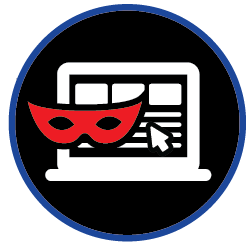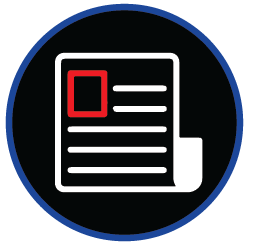
Web Application Hijack Susceptibility
ThreatNG Score Unveils Web App Hijacking Risks Across Your Digital Ecosystem
The ThreatNG Web Application Hijack Susceptibility Score offers a decisive advantage for organizations seeking a holistic understanding of this vulnerability. Unlike traditional security ratings, ThreatNG leverages External Attack Surface Management (EASM), Digital Risk Protection (DRP), and expansive intelligence sources to assess your organization, third-party vendors, and the entire supply chain. This comprehensive approach, bolstered by in-depth domain analysis, pinpoints potential weaknesses in web applications—the very points attackers target. This proactive approach empowers businesses to make informed decisions and achieve optimal security outcomes.
ThreatNG Web Application Hijack Susceptibility Score: Severity Levels Explained
The ThreatNG Web Application Hijack Susceptibility Score uses a letter grading system (A-F) to communicate the severity of your web application's vulnerability to hijacking. This grading system aligns with the ThreatNG Digital Presence Triad, providing a clear picture of the risk based on three key factors:
Feasibility
This considers how easy it would be for an attacker to exploit a weakness in your web application. Grade A indicates a highly secure application with solid defenses against hijacking attempts. Conversely, Grade F signifies a highly vulnerable application with readily exploitable weaknesses.
Believability
Assesses the likelihood of an attacker targeting your application. A low score (A) suggests a low chance of being targeted. In contrast, a high score (F) indicates a high likelihood of being targeted due to factors like industry or past security incidents.
Impact
Avaluates the potential consequences of a successful hijacking. Grade A signifies minimal potential damage, while Grade F indicates a scenario with severe financial losses, reputational damage, or data breaches.
How the Grades Translate to Severity
A (Low Severity)
Your application has robust security measures, a low attacker interest, and minimal potential impact if compromised.
B (Moderate Severity)
While your application might have some vulnerabilities, attacker interest is still considered low, or the potential impact is manageable.
C (Medium Severity)
This indicates a balance between vulnerability, attacker interest, and potential impact. Remediation efforts are recommended to address these moderate risks.
D (High Severity)
Your application shows vulnerabilities that could be exploited with moderate attacker interest or have significant consequences if compromised. Urgent action is needed to address these vulnerabilities.
F (Critical Severity)
This signifies the highest risk scenario. Your application has critical vulnerabilities, is highly likely to be targeted, and could suffer severe consequences if hijacked. Immediate remediation is crucial.
The ThreatNG Advantage
Considering all three factors (Feasibility, Believability, and Impact), the ThreatNG score surpasses a simple vulnerability scan. It prioritizes risks based on real-world scenarios, allowing you to focus resources on areas with the most significant potential for damage. This focus on the Digital Presence Triad helps organizations achieve optimal security outcomes by first addressing the most critical vulnerabilities.

Unveiling Actionable Web App Security with ThreatNG's Data-Driven Score
The ThreatNG Web Application Hijack Susceptibility Score breaks the mold of traditional security ratings by offering a wealth of actionable insights fueled by a powerful combination of data and intelligence. This approach empowers organizations to manage web application security and achieve optimal results proactively.
Actionable Insights and Data-Driven Objectivity
ThreatNG goes beyond simply identifying vulnerabilities. By leveraging External Attack Surface Management (EASM) and Digital Risk Protection (DRP) capabilities, the score analyzes your entire digital ecosystem, including third-party vendors and your supply chain. This comprehensive view, bolstered by vast intelligence repositories, paints an objective picture of your web application's hijacking risk. With this data-driven approach, you gain actionable insights prioritizing real threats empowering informed decision-making.
Continuous Monitoring and Improvement
ThreatNG isn't a one-time assessment. Its continuous monitoring capabilities provide ongoing security insights, allowing you to track progress and identify new vulnerabilities as they emerge. This empowers a proactive security posture, enabling you to adapt and improve your defenses.
Comparison and Benchmarking
The ThreatNG score allows for comparison and benchmarking against industry standards or your historical data. This comparative analysis helps you understand your security posture relative to others and measure the effectiveness of your remediation efforts.
Actionable Recommendations
The score doesn't just highlight problems; it provides clear, actionable recommendations for addressing vulnerabilities. These recommendations are tailored to the specific details of your application and the identified risks, allowing you to prioritize resources and focus your efforts where they will have the most significant impact.
Clear and Transparent Scoring
ThreatNG's scoring system is clear and transparent. Because it is substantiated by the results of EASM, DRP, and extensive intelligence repositories, the score provides a verifiable and objective assessment of your web application's security posture. This transparency fosters trust and empowers stakeholders to make informed security decisions confidently.

ThreatNG Unveils Broader Security Landscape: Beyond Web App Hijacking
The ThreatNG Web Application Hijack Susceptibility Score is a powerful tool, but it's just one facet of ThreatNG's comprehensive security assessment capabilities. While this score hones in on web application hijacking risks, ThreatNG offers a broader range of Susceptibility and Exposure ratings that paint a holistic picture of your organization's digital security posture.
Here's what sets ThreatNG apart:
Multifaceted Approach
ThreatNG goes beyond traditional vulnerability scans. It leverages External Attack Surface Management (EASM) and Digital Risk Protection (DRP) to assess your organization, your third-party vendors, and the entire supply chain. This holistic view identifies vulnerabilities across your digital ecosystem, empowering a more strategic security approach.
Actionable Insights
ThreatNG doesn't just identify problems; it provides actionable recommendations for mitigating risks across all assessed areas. It empowers you to prioritize resources and address the most critical vulnerabilities first.
Data-Driven Decisions
The ThreatNG ratings are data-driven and objective, substantiated by EASM, DRP, and extensive intelligence repositories. This transparency fosters trust and empowers stakeholders to make informed security decisions confidently.
Why Assessing Every Angle Matters
While web application hijacking is a significant threat, it's just one piece of the puzzle. Organizations today face a complex and ever-evolving threat landscape. Here's a glimpse into the additional Susceptibility and Exposure ratings offered by ThreatNG:
BEC & Phishing Susceptibility
Assesses the risk of falling victim to Business Email Compromise and phishing attacks.
Brand Damage Susceptibility
Evaluate the likelihood of negative brand impacts due to security incidents, financial violations, or social responsibility concerns.
Breach & Ransomware Susceptibility
Assesses the likelihood of falling victim to ransomware attacks, considering exposed ports, known vulnerabilities, and dark web presence
Cyber Risk Exposure
This section provides a broad view of external attack surface vulnerabilities, encompassing the technology stack, cloud environments, and code exposure.
Non-Human Identity (NHI) Exposure
Quantifies an organization's vulnerability to threats from leaked API keys, service accounts, and system credentials, which are often invisible to internal security tools.
Data Leak Susceptibility
Measures the potential for data breaches based on cloud configurations, SaaS usage, and code repository security.
Mobile App Exposure
Reveals mobile app vulnerabilities that, in conjunction with Web Application Hijack Susceptibility, increase an organization's risk of external attacks.
ESG Exposure
Evaluate the organization's environmental, social, and governance practices to identify potential security risks.
Supply Chain & Third Party Exposure
Analyzes the security posture of your vendors and partners, highlighting potential vulnerabilities within your supply chain.
Subdomain Takeover Susceptibility
Identifies weaknesses in subdomain configurations that could allow attackers to take control.

Security Ratings Use Cases
ThreatNG is a security rating platform enabling businesses to evaluate and monitor their security posture and that of their third-party vendors. By leveraging our extensive security information database, ThreatNG provides valuable insights into potential vulnerabilities and risk exposure, enabling organizations to take proactive measures to strengthen their security defenses. This section will explore some use cases where ThreatNG's security ratings can help organizations better understand their security posture and mitigate risk.




























